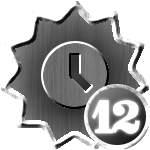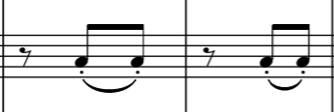-
Posts
353 -
Joined
-
Last visited
-
Days Won
32
danishali903 last won the day on July 1
danishali903 had the most liked content!
About danishali903

Profile Information
-
Gender
Male
-
Location
Troy, MI
-
Interests
Music (duh), Movies (good ones), Books (the classics)
-
Favorite Composers
Mahler, Bartok, Beethoven, Mozart, Tchaikovsky, Brahms, JS Bach, JC Bach, John Williams, Vaughn-Williams, Stravinsky, Rachmaninoff, Prokofiev, Rimsky-Korsakov, Ravel, Shostakovich, R. Strauss
-
My Compositional Styles
Neo-romantic, neo-classical
-
Notation Software/Sequencers
finale 2014.5 and GPO 4
-
Instruments Played
Violin, Viola
Recent Profile Visitors
danishali903's Achievements
-

Advice on writing slurs for strings in orchestral music
danishali903 replied to JordiHortal's topic in Advice and Techniques
String player here as well. @HoYin Cheung has given great suggestions/advice. Side note: I'm currently marking bowings for an orchestra to perform Brahms Symphony 4, and Brahms loved his long slurs! Most of them are impractical and I think he didn't really think about how that would translate to the musician playing...but they do give an insight to how he wanted the players to phrase the music. I rarely mark bowings in my own music as I think it depends on the player/section/orchestra and how their style/approach to music. -
Not to belittle anyone or be pretentious, but I think it's best to use the correct terminology when discussing these things. A piece can have several movements. Think of the piece (for example, lets say Beethoven's 5th Symphony) as a novel, and a movement as a chapter of that novel (in our example, there are four movements in that symphony). Movements don't have to be similar (melodically or harmonically) and can have varied moods or personalities. Pieces can have anywhere from 2 movements to infinite (a bit impractical and illogical, but theoretically possible). Most of the time, there is a unifying element that tie together the movements, be it musical or external narrative. There are cases where movements are so different from each other that they can be their own pieces, but that is a rare occurrence.
-

New Waltz in C Major for String Quartet or Piano Quintet
danishali903 replied to Chemathmusician0510's topic in Chamber Music
Just to clarify, I'm not saying the composition itself is basic. It's the string writing that's "basic"...as in there seems to be these defined roles akin to a 4 part choir (1st violin = soprano, 2nd = alto, etc.) -
Very charming! I'm definitely getting a Beethoven/Brahms vibe from this movement. The modulation to D major in the exposition is unexpected, but it works! The 2nd ending/intro of the development is a little odd. I think a little more motion from the piano into bar 102 would make the transition smoother (suggestion: maybe the violin motif in 102 could be played in the piano bass line at the 2nd ending). Another minor suggestion (and this one is just a personal preference)...3 before the end, maybe have the violin play a pizzicato B-flat major chord (maybe without the piano). The violin writing is very idiomatic for the instrument. The piano writing seems fine to me...though not a pianist myself.
-

New Waltz in C Major for String Quartet or Piano Quintet
danishali903 replied to Chemathmusician0510's topic in Chamber Music
Firstly, I think the audio rendering doesn't do this piece justice. Everything sounds too muddy, and I can barely hear the 2nd violin and viola parts coming through. As to the String Quartet vs Piano Quintet, I don't see the value of having a piano added since it seems to be doubling what's going on in the strings. Leaving this as a string quartet piece would be more logical. Your string writing isn't bad...but it's very "basic". Each instrument/part seems to have a pre-defined range, and the music rarely goes in and out of that range. Maybe throw the melody to the cellist in its higher ranges, or have the viola play something other than this accompaniment role: I also think the transition to the trio section (somewhere around bars 80-82) can be a little more developed, as the trio (bar 83) is VERY different from what came before....just a bit jarring. It might work better, and be a little more interesting, to have that section in a major key. Otherwise, a bit more counterpoint material can help as well. It just sounds very homophonic at the moment. Last comment: The outer sections could use dynamic and phrasing marks. -
Getting back into composition from a long hiatus, I decided to orchestrate a piano piece by Claude Debussy. The piece is a movement from his piano suite Estampes titled La Soireé dans Granade (Evening in Granada). I'm still not too familiar with Debussy's piano music as a whole, but this suite definitely piqued my interest in that genre. I wasn't aware at the time, but several high profiled figures have orchestrated this movement (and other movements of the suite), and I did avoid listening to them so I don't copy them. Link to the original piano composition: The audio quality is a little meh...this is the last piece I wrote before I switched out of Finale/Garritan to Dorico/NotePerformer. Any feedback is appreciated!
-

Rhapsody for Symphony Orchestra
danishali903 replied to A Ko's topic in Orchestral and Large Ensemble
This is quite good for a first attempt at orchestral writing! I definitely hear allusions to other composers' works (Mahler, Dvorak, and Sibelius come to mind...with a hint of Bruckner). I do take issue with the title of the piece. When I think "Rhapsody", I expect something a little more virtuosic...doesn't have to be "fast", but needs more ornamentation and something show-off-y. I would call this maybe an "Orchestral Fantasy" due to its episodic form. Orchestration is a little odd for winds. You can probably reduce the flute section to just 2 + piccolo. You can also probably reduce to 4 horns. Strange there are no trumpets or additional trombones. The scoring is a bit haphazard and confusing as you can't tell which wind part is suppose to play when (unless they are constantly doubled?) Also, I've never seen a horn part using the tenor clef (and for some reason its only in Horns 5/6). -

Debussy orchestration (Footsteps in the Snow)
danishali903 replied to Alex Weidmann's topic in Orchestral and Large Ensemble
The orchestration is simple, yet effective. I like the sparseness of it all, and would not add in any percussion/keyboard instruments as suggested above. However, the instrumentation is a little odd, but it works for me. You should definitely remove those ppppp dynamics. For strings, I would recommend doing it all con sordino. -
It's clear it took a lot of effort and thought to write this work, so kudos! The orchestration, attention to melody, and engraving are the highlights for me (my score engraving is quite horrendous, so this is quite impressive!). Your solo violin writing isn't that bad...there are a few technical difficult spots here and there. My biggest concern is that the solo violin plays continuously, and since it's a REALLY long piece, the soloist is probably going to lose steam halfway through the 2nd movement. To me, this is less "Violin Concerto", and more a Symphony with Violin Obligato. Each movement does seem to have a structure/roadmap, but sometimes, some sections are unnecessarily prolonged, or they seem really random...Here are my thoughts for each movement: First movement: Probably my favorite of the three, and the most cohesive in structure. I hear a little bit of Dvorak's influence in there. Everything seems good until, measure 155. 155 to about 195 seems like I've entered a different movement, and it's very jarring how different the tone and atmosphere is compared to the everything else. For a movement in A minor, I'm surprised you don't explore the material in A major or C major....But overall not too bad! Second movement: Not a big fan of this movement. There was not a cohesive structure, and I feel like you were trying to throw a LOT of stuff in here to fill out the movement, and it did not gel for me. I kinda liked the section at A, with the Gershwin-esque jazzyness....even though it didn't quite match the tone of the first movement...but I still enjoyed it! I think you can expand that section a little more. The sudden shift in measure 68 however was jarring, but weirdly that was what I was expecting the 2nd movement would sound like more, and it flows very well from the 1st movement, and the introduction of the 2nd movement. Then there is a complete tone shift at letter F...did not like it. Might've worked better if the previous section was more developed and the transition material worked, but the shift in tone did not sit well with me. The tone does shift again....at measure 110. Personally, I would omit everything F and 110, it would flow much better. I would also developed ending little more, and make it a little less thick, orchestration-wise...maybe just the violin and strings...and do an attacca into the next movement. Third movement: I have to be honest here...I couldn't listen to the whole movement, and had to skip around some sections. This movement is unnecessarily really long, and really taxing on the solo violinist, the orchestra, and the listener. I think you were going for a Rondo-esque form here...but some of it was really superfluous. It started off really well, with the melodic material brought back from the first movement. I really like the cadenza moment at 93, and I think that should be heavily expanded! Measure 125 (and whenever that is repeated later) should have varied orchestration...gets kinda boring with the exact same material. Plus the solo violinist does need a rest from all those ricochet arpeggios. Transition at 130 starts out great, and the material that follows is intriguing....but it feels like I've entered a whole different violin concerto at 150. It suddenly goes from a romantic sounding work to something Bartok/Madonna would've written (VEERRRRRRYYYYYY jarring). We return back to the main material at 204, but that gets interrupted by a a Beethoven-esque scherzo at 242, which still somewhat fits better. Around measure 400, I was starting to lose interest....measure 424 could use some counterpoint to keep things moving. The whole section from 445-470 is very meandering, and can probably be omitted. Same for after the cadenza at 523-533. I think you were trying to throw different things together and hoping the hodgepodge of different styles/melodies come together, but it's not working. There are barely any rests for the solo violin, and thought it's not overly technical...it is EXTREMELY long.
-

The Clash of Cultures (for String Orchestra)
danishali903 replied to Samuel Tang's topic in Orchestral and Large Ensemble
This is quite good! Your string writing is nice, but I think the score is in desperate need of phrasing markings (slurs, bowings, articulation markings, etc.)! Adding more tempo fluidity might help with phrasing as well...but I guess that's more of a subjective take. I do agree with @Luis Hernández that the piece does get a little tiresome due to the homophonic nature. I think there are areas where some counterpoint/development would be beneficial (especially towards the end of the piece). -

Symphony #2 in C minor - 4-Allegro ma non troppo
danishali903 replied to Marc Deflin's topic in Orchestral and Large Ensemble
Disclaimer: I haven't listened to the other movements, but I will in time. I echo what @malumCompositorsaid about a lack of structure. You have some good ideas here and there, but they seem to be severely disjointed. Try to not to cram everything at once. I did like the motivic figure and its subsequent development from measures 9-16. There are also a lot of questionable harmonic/melodic choices...For starters, the key signature at the beginning is in C minor, but the material is in G major...and it mostly stays in the G major/minor-ish tonality the rest of the piece. There are odd harmonic progressions (the last few measures of the movement for example), harmonic clashes (flute/oboe around 97, B natural in bassoon at 96)....even if intentional, sound very odd. Your string writing is alright. Wind writing on the other hand needs more polish. Overall, a little orchestration studying might be helpful, just to get a general idea of the capabilities for each instrument. -

Poem for Marimba and String Orchestra
danishali903 replied to Petar Dimov's topic in Orchestral and Large Ensemble
Very interesting work! Your string writing is excellent. Not an expert on Marimba, so can't really comment on the playability...but it looks challenging. I also liked the fact that the piece does follow the sonata structure and is very concise. Very well done! Hopefully you get to post a live recording of the piece soon 🙂 -

2nd movement, symphony No.2
danishali903 replied to Leonardo C. Núñez's topic in Orchestral and Large Ensemble
Very impressive for a 17 year old...great job! The movement has very Shostakovich-esque qualities. I think @Tónskáld did a good job of explaining the things I was going to mention. -

SUMMER 2020 COMPETITION ANNOUNCEMENT
danishali903 replied to Monarcheon's topic in Monthly Competitions
I am gonna throw my hat in and enter as an entrant. Should be fun! -

Lacrimosa for Piano Quartet, Op. 11
danishali903 replied to Theodore Servin's topic in Chamber Music
This is quite impressive! Some parts reminded me of something Schubert would write, some had a more Rachmaninoff quality to them. Beautiful recording as well. It'd be nice to see a score too. If you need a violist in the future, I am at your service 🙂








.thumb.png.8b5b433a341551e913a34392660bc95b.png)








